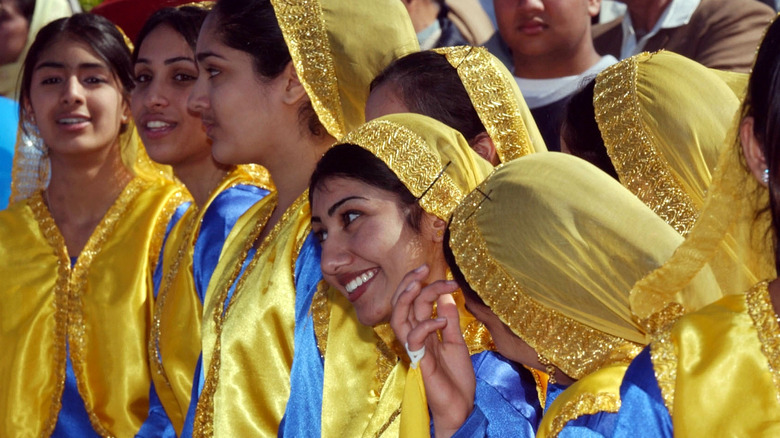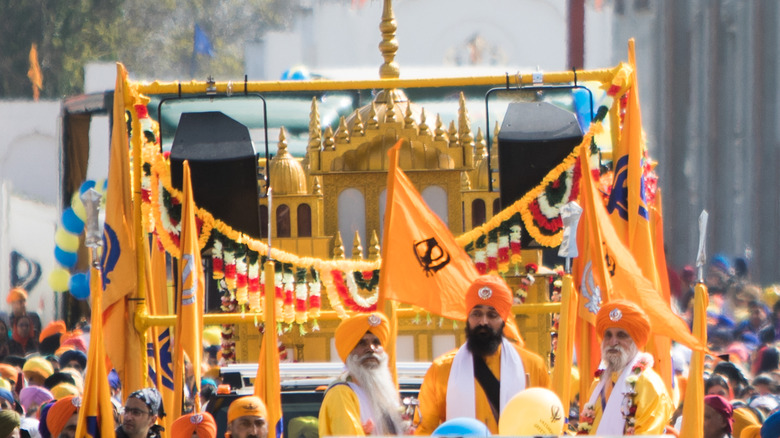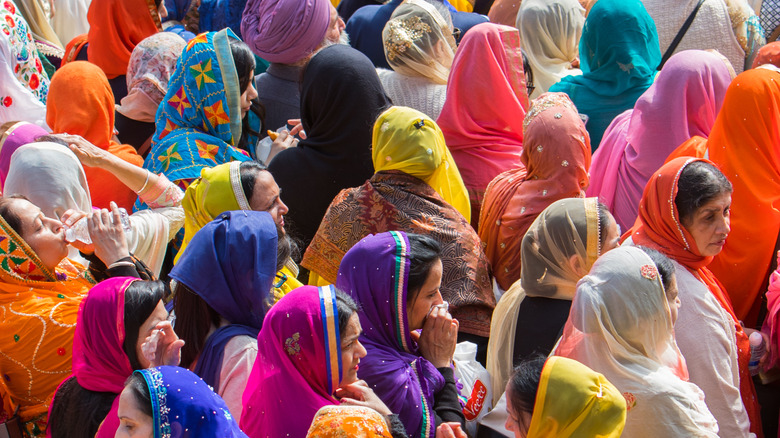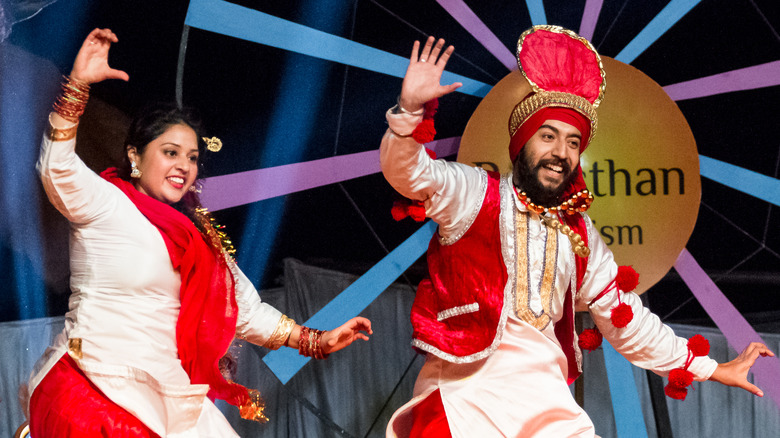What Is Vaisakhi And Why Is It Celebrated?
Observed primarily by Hindus and Sikhs, Vaisakhi, sometimes called Baisakhi, is a traditional harvest celebration that most often marks the start of the Sikh new year. On Western calendars, Vaisakhi typically takes place either on April 13 or 14, as the BBC reports. Per The Conversation, there are an estimated 30 million Sikhs worldwide, ranking Sikhism fifth among all major religious beliefs. That's while there are roughly one billion observant Hindus, placing that faith fourth on the list, via the Pew Research Center. For these reasons and more, Vaisakhi is a very important date on the calendar for a very large portion of the global population. An Canadian Vaisakhi parade is pictured above.
Sikhism and Hinduism are two distinct religions that originated in India, as Diffen explains. It's also important to note that Vaisakhi is not technically considered a religious observance in the view of the Sikhs, as that tradition does not call any one day more "holy" than another, as The Daily Beast explains. Vaisakhi should instead be considered a community event or festival, celebrating the harvest, growth, and overall progress as a collective, among other similar values. Originating around 1699 from the Punjabi region of India, it's also commonly believed that Vaisakhi marks the beginning of the Sikh faith itself, but that's not actually the case (via The Daily Beast).
Roots of Vaisakhi in Sikhism and Hinduism
As The Daily Beast also explains, Vaisakhi's origins actually trace back several centuries. According to the BBC, Vaisakhi became associated with Sikhism when a foundational guru in the Sikh religion, Guru Gobind Singh, chose the date to establish the Khalsa — the collective term Sikhs use for any member of the faith who is baptized. This all took place during a period of political tension between India's reigning Mughals empire and the Sikh minority. Through the first Vaisakhi, Singh established the Khalsa Panth, or Panj Pyare, a ruling body of the religion that exists in some form to this very day (via Prekṣā).
Vaisakhi is also observed by Hindus. One difference is that some Hindu sects observe Vaisakhi in conjunction with the week-long Diwali Festival, which also marks the Hindu New Year, as National World reports. (Diwali is in October, meaning Vaisakhi is in the fall rather than spring for some Hindus, and not among Sikhs, via India Today). Additional ways some Hindus observe Vaisakhi include ritual bathing in Indian rivers such as the Ganges, and others. Hindus also frequently gather at temples where the celebrate and feast with family and friends, just like the Sikhs.
Vaisakhi spreads around the world
As Sikhism and Hinduism spread worldwide, Vaisakhi is now observed almost everywhere. What's more, Vaisakhi is not just observed by Hindus and Sikhs, according to National World. Secular Muslims and even Christians now celebrate the festival, and slight variations on Vaisakhi are also observed by Buddhists in some parts of Asia, particularly in the South and Southeastern areas of the continent. Vaisakhi is also observed in Canada, and all over the United Kingdom, (per the CBC Kids). It's also observed in many American states, per Hindustan Times.
No matter where Vaisakhi takes place, something called "Langar" is an important part of the celebration. Via Pure Punajabi, "Langar" refers to the food served in Sikh temples, also called Gurdwaras, and during Vaisakhi, it's important that food is given away freely to everyone, so that the needy or well-fed alike can gather and share a good meal (via CBS Kids). Visiting friends and family is also an important part of Vaisakhi in many regions, and so, too, is the wearing of special types of brightly colored clothing. One particular order of Sikhs, the Nihang, even practice martial arts and horsemanship as part of the festival (via National World).
Vaisakhi and Banghra dancing
Another particularly important part of a Vaisakhi celebration in many parts of the world is Bhangra dancing, according to CBC Kids. Performed along with a traditional kind of drum called a dhol, the Bhangra is traditionally danced by men and it developed in the Punjabi region of India during the 14th century as a means for celebrate the harvest. These days, though, just as many women dance the Bhangra as men. The Bhangra is otherwise marked by bright costumes worn by the dancers, and the Bhangra is danced more often than just during Vaisakhi, including at birthday parties and marriages, among other events (per Britannica).
Other signature ways Vaisakhi is celebrated include observant Hindus and Sikhs gathering a Gurdwaras or Hindu temples to worship, according to the BBC. There are also bright and colorful parades and processions called Nagar kirtans, during which participants sing from the Guru Granth Sahib, the Sikh holy book. Generally speaking, the occasion is marked by chanting, singing, and reading from scripture, and many Sikhs also choose Vaisakhi to be baptized. One of the biggest Vaisakhi celebrations takes place each year at Anandpur Sahib in the Indian Punjabi region, where the Khalsa was first established.



